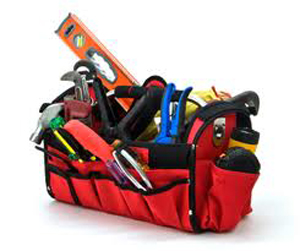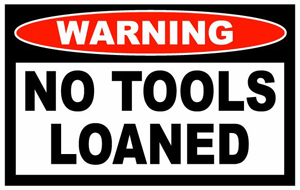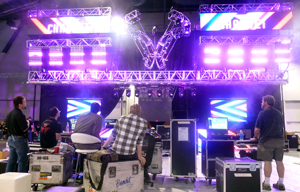Tech Talk: ‘Hey, That’s My Wrench in Your Bag!’
Posted on November 26, 2012Written by Mike Graham, product manager for CHAUVET Professional
I can’t tell you how many times I’ve said that over the past 20 years. Too many times to count, that’s for sure. However, there are some simple and easy ways to make sure that the tools and gear you showed up with at the job or show site actually go home with you.
Nothing is more frustrating than seeing that shiny new Crescent wrench you just laid out $10 for in someone else’s tool bag. OK, there are more frustrating things, but you get the point. But, how could I have stopped it? Read on and follow my tips, all gathered from experience:
I. How to protect your own tools.
• Much like a wolf, mark your territory. Copying the wolf exactly may not be a good idea, as your tool bag will start to smell. It’s the same concept though: mark your tools with something distinctive. You can engrave them with your name, or put a ring of colored tape on them, or spray paint them in some color (like hot pink) that you know is your mark. This will slow the other wolves from long-term borrowing your precious matt knife.
 • Take out of the bag only the tools you use. Since on the show and job site, there are some tools that should never leave your box, and some that are in your hands all of the time, it is important to keep the ones in your box away from the eyes of others and only taken out when needed. This would include any tool that requires a battery for operation. Typically, those are much more expensive to replace. As for the stuff that goes in your pockets, like a C-wrench, #2 Philips head, snips, and a matt knife, you have to know where they are. Keep them in your pocket and make sure that they are clearly marked as yours. I picked up a ratcheting C-wrench about a year ago. For me, it’s great. I finally got used to working with it at LDI 2012. Someone who shall rename nameless decided to grab it from where I was working to “try it out” on the last show. Since it is marked with a particular string with a particular knot, it was easy for me to spot out and ask for my wrench back. Years ago, my best friend went out and picked up a PowerPuff Girls lunch bag that he used for his tools. I must have laughed at him for months, but he could have put a hundred dollars in that bag and no one would have touched it. Moral of the story, be the wolf.
• Take out of the bag only the tools you use. Since on the show and job site, there are some tools that should never leave your box, and some that are in your hands all of the time, it is important to keep the ones in your box away from the eyes of others and only taken out when needed. This would include any tool that requires a battery for operation. Typically, those are much more expensive to replace. As for the stuff that goes in your pockets, like a C-wrench, #2 Philips head, snips, and a matt knife, you have to know where they are. Keep them in your pocket and make sure that they are clearly marked as yours. I picked up a ratcheting C-wrench about a year ago. For me, it’s great. I finally got used to working with it at LDI 2012. Someone who shall rename nameless decided to grab it from where I was working to “try it out” on the last show. Since it is marked with a particular string with a particular knot, it was easy for me to spot out and ask for my wrench back. Years ago, my best friend went out and picked up a PowerPuff Girls lunch bag that he used for his tools. I must have laughed at him for months, but he could have put a hundred dollars in that bag and no one would have touched it. Moral of the story, be the wolf.
II. Tips on handling equipment from rental houses.
Years ago, when I was tending bar, all of the bartenders on the avenue would get together once a month to share war stories and exchange glassware. We did this because throughout the month, without fail, we would have everyone else’s shot glasses but our own. That works fine for a group of friendly bartenders, not so hot for very competitive rental houses.
 If you are in a position where you are going to have to use multiple vendors to cover your show needs (commonly known as re-renting) you know that you had better get them their gear back to the last truss bolt. Sometimes that can be tricky, especially if you are using multiple vendors for the same gear, which is always a nightmare scenario during load out. Most times, rental companies label their gear clearly with a sticker that has their name on it. They may also use a distinctive color code. For example, Christie Lites uses purple 3-pin DMX cable and green 5-pin data cable. Now, more and more companies are also including bar codes to make inventory faster. They know that if the barcode does not work, it’s not their gear. If for some reason, company A and company B have decided not to mark their gear, then it is up to you to do so to avoid the nastygram that will follow their gear count at the shop. This is where you get to find out how much they paid for an item three years ago when it was brand new as you are having to buy them a new one. There are ways to keep this from happening:
If you are in a position where you are going to have to use multiple vendors to cover your show needs (commonly known as re-renting) you know that you had better get them their gear back to the last truss bolt. Sometimes that can be tricky, especially if you are using multiple vendors for the same gear, which is always a nightmare scenario during load out. Most times, rental companies label their gear clearly with a sticker that has their name on it. They may also use a distinctive color code. For example, Christie Lites uses purple 3-pin DMX cable and green 5-pin data cable. Now, more and more companies are also including bar codes to make inventory faster. They know that if the barcode does not work, it’s not their gear. If for some reason, company A and company B have decided not to mark their gear, then it is up to you to do so to avoid the nastygram that will follow their gear count at the shop. This is where you get to find out how much they paid for an item three years ago when it was brand new as you are having to buy them a new one. There are ways to keep this from happening:
• Use multicolored electrical tape. The easiest way is to use multicolored electrical tape. (you should always have at least two other colors besides black electrical tape in your box). Use one color for company A and another for company B.
• The other way is to try to segregate gear in specific locations, which is fine if you are working alone, but is not at all an option when working with others. When you re-box their stuff, make sure that the gear list matches; especially on the items that had to be re-rented. This will save you a major headache at the end. If for any reason your rental company did not send a complete packing list with the exact count of cables, call them and demand one. Without that, you are going to be in deep wolf stuff when you are trying to get the right gear back to the right location at the end.
At the end of the day, producing a show is expensive for everyone. On a given show, there are expenses for flights, hotels, trucking, labor, repairs, gear rentals and incidentals. You can’t charge the client for the wrench we lost or the gear that is missing at the end of the show. You have to eat those costs. Those costs directly impact your bottom line for the show and can kill the profit margins. It might not seem like much at the time, but even a good matt knife is still $10. Putting company A’s gear back in company B’s box can be even more costly.

